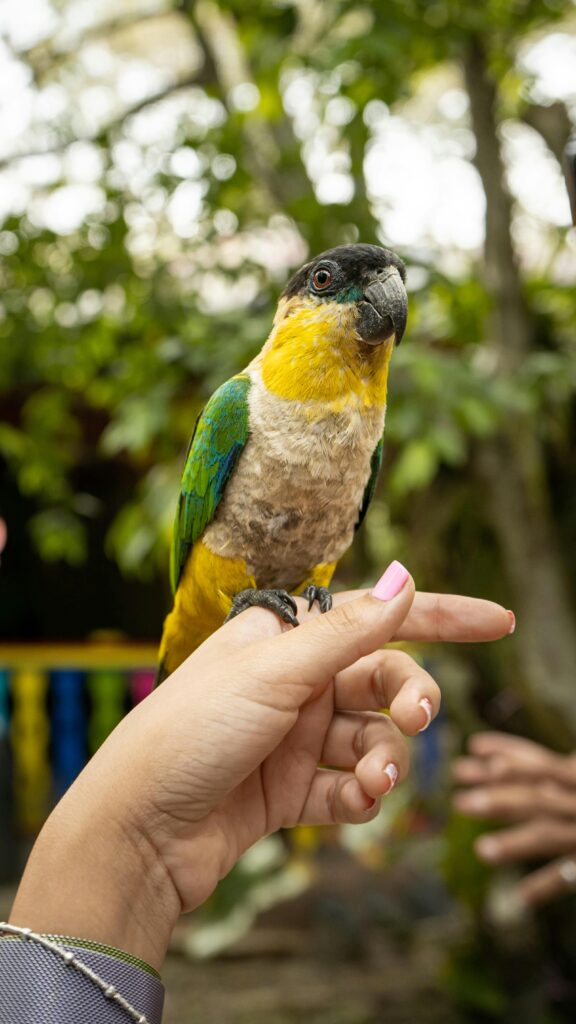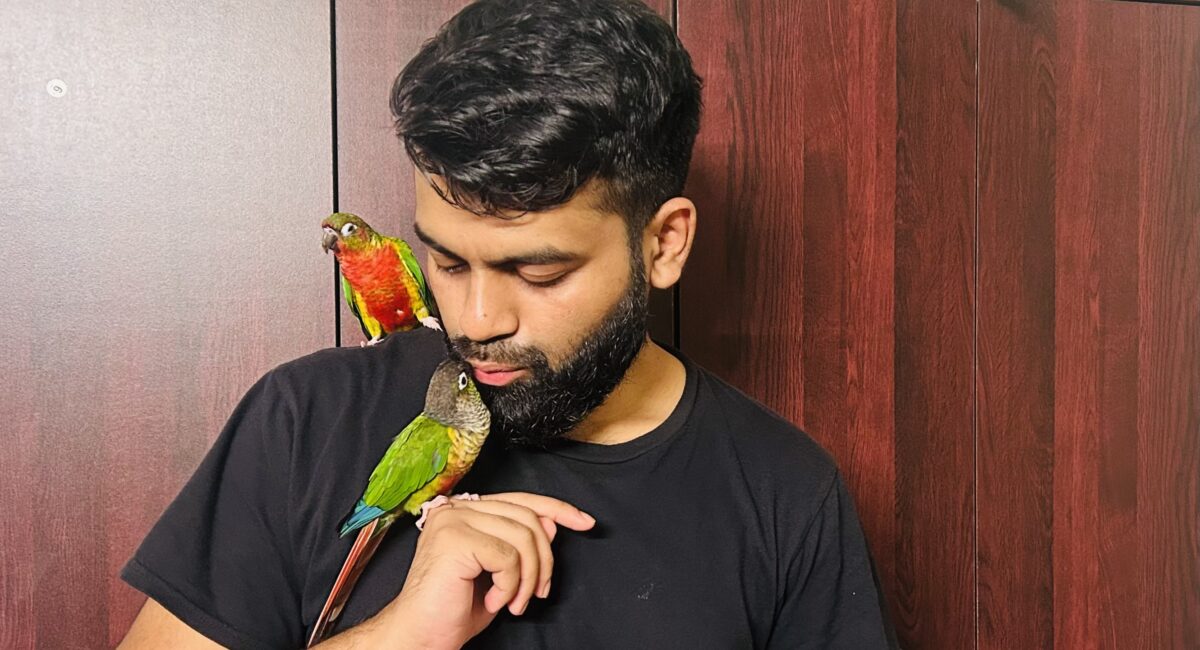The Most Popular and 9 Easy Tricks to Teach Your Parrots
If you have ever spent time with some amazing parrots, you will know how clever and funny they are. Over the years, I have enjoyed teaching my parrots all sorts of fun tricks and have found these 9 to be the simplest and most requested that have brought so much joy and bonding to my home. These tricks are incredibly basic, easy to teach, and a little simpler than some of the other parrot tricks. So, let’s get started and learn the most popular and 9 easy tricks to teach your parrots!
Some highly intelligent parrots need something to do all the time; nothing is more boring for a parrot than sitting in its cage doing absolutely nothing as this makes them feather pluck or scream. Training makes the bird more social and interactive with the owner.
Benefits of Teaching Tricks
- Mental Stimulation- Tricks are a great way to keep your parrot’s mind sharp and its brain stimulated.
- Physical activity- About half a dozen of the listed tricks involve movement, which allows your parrot to work off some calories.
- Quality time- Training sessions can be the perfect bonding time for you and your parrot.
- Positive behavior reinforcement- While you teach tricks, your parrots will also model good behavior and develop fewer chances to engage in negative habits.
Basic Commands to Begin With
1. Step-Up Command
Step-up is one of the first, and most fundamental commands that you should teach your parrots. It is accomplished by teaching your parrot to step onto your hand or a perch. Before starting, make sure your parrot is relaxed and within familiar surroundings.
- Step 1: Hold the perch or your finger close to the body of your parrot, above the waistline.
- Step 2: Calmly say “step up.”
- Step 3: Gently push your parrot’s chest to make them step onto your finger or a perch.
- Step 4: As soon as they step up, you should reward your parrots with treats and praise.
You must remember that positive reinforcement is the absolute most important factor in perfecting the step-up command. Practice this on a daily basis while using treats and vocal praise to reward the behavior. By doing this many times, your parrot will learn that when you ask for him or her to enter their carrier and they do, the result is positive since it was followed by a click!

2. Turn Around Trick
This is my favorite one and it’s a nice-looking trick. You can guide your parrot in a circle like to have them follow the target stick.
- Step 1: Give your bird a chance to become acquainted with and touch the target stick.
- Step 2: Direct your stick close to your parrot’s mouth and gradually spin it.
- Step 3: As you move the stick in a circle, say “Turn around”.
- Step 4: Once your parrot has gone all the way, reward it with a treat or verbal praise for the effort.
A target stick for parrot training is a pretty nifty tool. It helps to guide their movements and gives a clear visual representation of the action you want them to perform. Make sure you always reinforce picking up the stick.
3. Wave Command
This is another simple trick in which your parrot lifts one foot as if to wave hello.
- Step 1: Begin the Step-Up Command.
- Step 2: Drag your hand slightly out of reach. At this moment, look for your parrot to lift its paw.
- Step 3: Once your parrot has picked up its foot, say “wave.”
- Step 4: Offer a treat and praise immediately when you see your parrot lift its foot.
4. Fetch Trick
Playing fetch is a fun trick and keeps your parrot stimulated mentally while getting some exercise. Begin with an item that is light and comfortable to hold.
- Step 1: You should use a small toy, or ball that your parrot is able to grab effortlessly.
- Step 2: Show the object to your parrot, and encourage your bird to touch or grab it.
- Step 3: Twist the object and gently throw it into a soft explosion.
- Step 4: As your parrot moves towards the object, say “fetch”
- Step 5: When your parrot picks up and brings you the object, treat it with a treat.
5. Shake Hands Command

I found this tutorial to teach my parrot how to shake hands which is incredibly cute. I’m still teaching this kind of trick to some of my parrot
- Step 1: Have your parrot in the step-up position.Step 2: Now hold your finger or a small perch in front of your parrot.Step 3: Say “shake hands” as you gently lift one of your parrot’s feet.Step 4: Give a treat and praise when your parrot lifts its foot immediately!
Do this again and again during every training session. Make sure your parrot does not get bored and keep sessions brief (5-10 mins). The shake hands command will take time, a little patience, and lots of consistency. Practice a few times a day with brief sessions to reinforce the behavior.
6. Speak or Mimic Words
A lot of bird owners like to teach their parrots how to speak words or even noises. You need to be patient because this one requires slow and steady practice.
- Step 1: Use simple, short words or sentences like “Hello,” or “Hi.”
- Step 2: Say the chosen word clearly and as often as you can, especially when your parrot is nicely focused.
- Step 3: Reward any effort, though the audio we are hearing is not ideal!
- Step 4: Match words with actions, and say hello upon entering a room.
To teach your bird to speak in clear words, accentuate the pronunciation, and make exaggerated faces. The mouth moves further by a parrot, this is again changed. Continue to be patient and hold the sessions brief yet interactive.
7. Dance Trick

Dancing can be fun and energetic and many parrots enjoy it. Make sure to choose the music wisely and this is how you can get your parrots down to the floor.
- Step 1: Select lively music that has a clear rhythm.
- Step 2: Dance along to show your parrot how to move.
- Step 3: Gently sway or bob your parrot to the music.
- Step 4: Give treats and praise whenever your parrot moves to the beat.
8. Play Dead Command
This is one of my favorite tricks. Play dead is a clever and fun trick where your parrot will lay on his back when you ask him to.
- Step 1: Make sure your parrot is relaxed and comfortable.
- Step 2: Carefully lay your parrot on its back on a soft surface.
- Step 3: Say “play dead” as you position your parrot.
- Step 4: Don’t forget to give treats and praise when your parrot stays in the position.
What matters the most is that you put your parrot’s comfort and safety first. Again, please understand that some parrots may not take to this position willingly and you should never force your parrot to do it.
Read More:
Lovebird Profiles and the Secret Behind Their Popularity
9. Ring the Bell Trick
Bell ringing is a really simple, and cute behavior that involves the parrot using its beak or foot to ring a small bell.
- Step 1: Allow your parrot to investigate the bell and become accustomed to its sound.
- Step 2: Ring the bell yourself to show your parrot how it is done.
- Step 3: Repeat the words “ring the bell” as your parrot touches it.
- Step 4: As soon as the parrot rings the bell, you should immediately praise and reward.
The method that can have great results with this trick is clicker training. The click noise symbolizes appropriate behavior, and a reward follows it. It will allow you to more clearly tie the action with the reward and help your parrot understand.
Challenges & Solutions
Parrots are known to be escape artists so training them can be quite a challenge. Being patient and understanding is a part of the journey. If your parrot seems stressed or uninterested, stop and give it a try later. Long, stern training can reduce your parrots’ will to learn; do simple and fast steps of teaching them anything. It is better to keep the training short and positive.
The key to good training is consistency. Stick to the same commands, and enjoy similar rewards as well as tips of training in the training process. Short, regular sessions are more effective than infrequent longer ones. Have a little patience and rejoice in small wins along the way.
Teaching your parrot tricks is a fulfilling way to bond and entertain them both mentally and physically. Begin with the simple commands and then move on to harder tricks. Be patient and use positive reinforcement through different stages of training. Have fun while you train your parrot!


